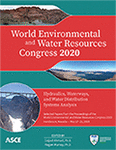World Environmental and Water Resources Congress 2020
Modeling and Design of a Multi-Use Fresh/Produced Water System with Significant Demand Variations
Publication: World Environmental and Water Resources Congress 2020: Hydraulics, Waterways, and Water Distribution Systems Analysis
ABSTRACT
A shale oil or gas field can have hundreds of wells. Each well needs a substantial amount of water in a relatively short period for hydraulic fracture with the water usage demand varying as a step function. These wells can be scheduled for development over a long period. Thus, a water system, routing fresh and produced water for hydraulic fracture of wells, is different from a conventional water distribution system since the fresh/produced water system has significant variations in demand as a function of time and location. This distinction can result in challenges to the hydraulic modeling and design of such systems. In this paper, an optimization methodology is presented to model and design a typical fresh/produced water system. First, all produced water is routed towards the active demand wells in the system. Since multiple flow paths may exist from a produced well to demand well, a flow path needs to be identified that will minimize the hydraulic head at each produced well. Second, a few freshwater sources from among all potential sources are selected by minimizing friction losses along the flow paths from the freshwater sources to the active demand wells, constrained by the freshwater source limits. Third, booster pumps are located and sized to minimize energy consumption and ensure there are no MAOP violations or no column separations in the entire system. A hydraulic model was developed for a hypothetical fresh/produced water system. The system was successfully optimized to use all produced water available before utilizing freshwater. The developed optimization methodology was validated by using the hypothetical system under specified operations. Utilizing a fresh/produced water system for hydraulic fracture is relatively new to the industry and has created the need for a unique optimization methodology to model and design such a system. This methodology was developed considering the significant variations in water usage demand hydraulic fracture creates.
Get full access to this article
View all available purchase options and get full access to this chapter.
REFERENCES
Mantell, M.E. “Produced Water Reuse and Recycling Challenges and Opportunities Across Major Shale Plays.” EPA Hydraulic Fracturing Study Technical Workshop #4: Water Resources Management, March 29-30, 2011.
Streeter, V.L. and Wylie, E.B. “Fluid Mechanics.” McGraw-Hill, 1979.
Dandy, G.C., Simpson, A.R., and Murphy, L.J. “A Review of Pipe Network Optimization Techniques.” The 23rd Australasian Conference on Technical Computing in the Water Industry, March 30 – April 1, 1993.
Information & Authors
Information
Published In
World Environmental and Water Resources Congress 2020: Hydraulics, Waterways, and Water Distribution Systems Analysis
Pages: 351 - 359
Editors: Sajjad Ahmad, Ph.D., and Regan Murray, Ph.D.
ISBN (Online): 978-0-7844-8297-1
Copyright
© 2020 American Society of Civil Engineers.
History
Published online: May 14, 2020
Published in print: May 14, 2020
Authors
Metrics & Citations
Metrics
Citations
Download citation
If you have the appropriate software installed, you can download article citation data to the citation manager of your choice. Simply select your manager software from the list below and click Download.
